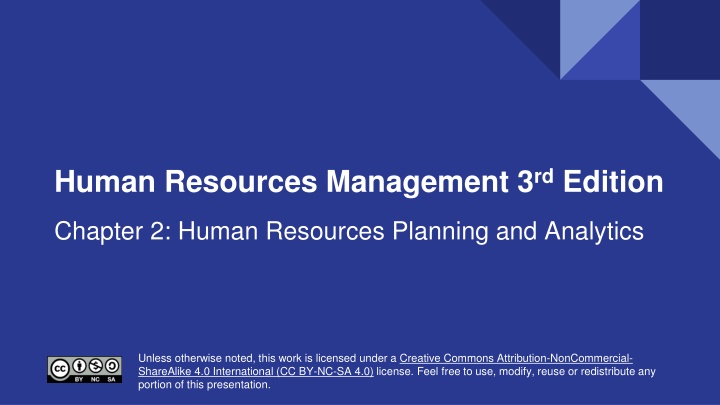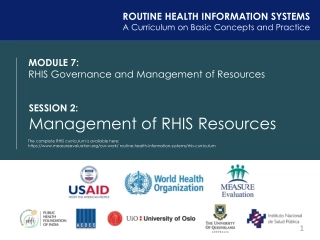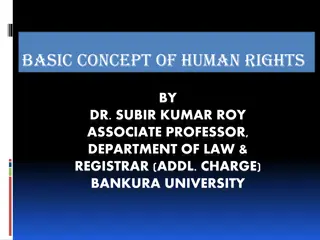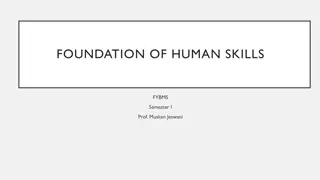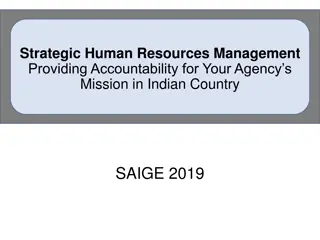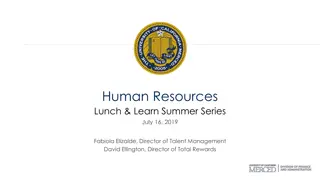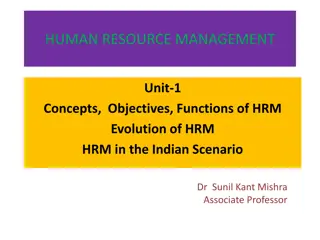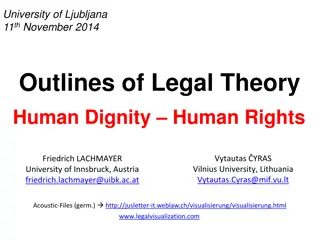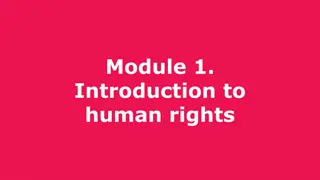Human Resources Management 3 rd Edition
Strategic human resources planning is essential for organizations to anticipate their future workforce needs and align them with business goals. This involves analyzing current and future demands, utilizing HR information systems and analytics, and forecasting labor requirements through various methods like trend projections and expert groups. By understanding these processes, HR departments can effectively plan and manage their human capital to support organizational success.
Download Presentation

Please find below an Image/Link to download the presentation.
The content on the website is provided AS IS for your information and personal use only. It may not be sold, licensed, or shared on other websites without obtaining consent from the author.If you encounter any issues during the download, it is possible that the publisher has removed the file from their server.
You are allowed to download the files provided on this website for personal or commercial use, subject to the condition that they are used lawfully. All files are the property of their respective owners.
The content on the website is provided AS IS for your information and personal use only. It may not be sold, licensed, or shared on other websites without obtaining consent from the author.
E N D
Presentation Transcript
Human Resources Management 3rdEdition Chapter 2: Human Resources Planning and Analytics Unless otherwise noted, this work is licensed under a Creative Commons Attribution-NonCommercial- ShareAlike 4.0 International (CC BY-NC-SA 4.0) license. Feel free to use, modify, reuse or redistribute any portion of this presentation.
Learning Outcomes 1. 2. 3. Discuss the importance of HR planning as it relates to strategy. Describe the HR planning process Discuss the methods companies use to estimate supply and demand of human capital. Explain the components of a human resources information system (HRIS) Describe how HRIS data and HR analytics has increased effectiveness of delivering HR services to employees. 4. 5.
2.1 Human Resources Planning And Strategy HR Planning is a strategic process that helps companies plan for future human resources that are needed to support the growth, or downsizing of production demands. It allows companies to predict the future, analyze the needs of the company, decide the market availability of candidates for specific jobs, and make decisions when and how to adapt and use human resources (people.) HR departments begin an HR Plan by predicting or anticipating the number of employees they will need with the expansion, and what skills the new employees will need to possess.
2.2 The HR Planning Process HR planning is a process of identifying the company s current and future people needs. It involves hiring the right people, creating an environment that supports employee s work, and develop the capacity to ensure the company s success. There are five main activities involved in HR Planning: 1. Review your business goals 2. Scan the environment 3. Identify the gaps 4. Develop your plan 5. Measure your progress This Photo by Meredith Snepp is licensed under CC BY-SA-NC
2.3 Forecasting Demand For Labour Forecast is an estimate of future human resources that a company needs to be successful. How companies forecast is weighted on several factors. Strategic Plan Legal Issues Competition Technology Turnover of employees Demographics Budgets This Photo by ResearchLeap is licensed under CC BY
2.4 HR Demand Forecasting Methods Nominal Group Method: a focus group of experts work face-to-face or virtually. Delphi Method: a group of experts predict specific future events through surveys and opinions. Trend Projections: Two methods are used with trend projections. Extrapolation uses past information related to change HR departments are responsible for ensuring the right and most appropriate methods are used for reliability and validity. Once the information is gathered, the results need to be converted to staffing tables.
2.5 Human Resources Supply There are two ways to solve staffing table needs: Internal supply are the existing employees who can be promoted to new positions, transferred to other departments or satellite offices, and could be demoted. External supply is hiring from outside the company. This Photo by PeopleMatters is licensed under CC BY-SA-NC
2.5 Estimating Internal Supply There are several methods HR departments use to track the supply of employees: Markov Analysis: future human resources needs that uses transitional probability matrices based on past data Human Resources Inventories: completed through HR audits of summaries of employees knowledge, skills and abilities (KSAs). Leadership and Management Inventories: similar to employee Human Resources Inventories. The KSAs are recorded. Replacement Charts: are like a picture that help to determine who can replace who when the need arises through a job opening.
2.5 Estimating External Supply: Labour Market Labour market analysis studies the companies labour market to assess the present and future availability of employees. Community Attitudes: The attitude of the local, national and international community affects the labour market. Demographics: Demographics affect the labour market in planning and trends for the future.
2.6 HR Response and Plan For Supply and Demand Leaves without pay Hiring Freeze Incentives to Leave Attrition Part-time employment Job Sharing Layoff Termination Early Retirement
Hiring New Employee s 2.6 Plan for Labour Shortages A labour shortage is not enough supply of employees to meet the demand for the company, and/or people do not have specific skills that company needs to operate the business. Good HR Planning through methods of tracking employees can avoid these situations. Contract Work Outsourcing Crowd- sourcing Overtime
2.7 Human Resources Information Systems (HRIS) and HR Analytics Today, every HR process has a technological element that enables it. A Human Resources Information System (HRIS) helps companies organize and manage people-related data. An HRIS system is an expensive and time- intensive commitment for any organization. The package selected should meet its current needs and have the flexibility to grow and expand with the organization into the foreseeable future. Benefits of HRIS Organization Compliance Time Savings Employee Experience Convenience HR Strategy
2.8 HR Analytics HR analytics is the process of analyzing this data in order to improve an organization s workforce performance. The process can also be referred to as talent analytics, people analytics, or even workforce analytics. HR analytics: HR analytics specifically deals with the metrics of the HR function, such as time to hire, training expense per employee, and time until promotion.. People analytics: People analytics, though often used as a synonym for HR analytics, is technically applicable to people in general. It can encompass any group of individuals even outside the organization.
2.8 HR Data Legal Considerations 1. Employee privacy and anonymity 2. Consent from employees about the amount and type of data collected 3. Establishing the goal of data collection and informing employees accordingly 4. IT security when using third-party software to run HR analytics 5. Location of the HR analytics vendor with whom the data will be stored and their compliance with local laws The type of data that is commonly collected in organizations: Revenue per employee Offer acceptance rate Training expenses per employee Training efficiency Voluntary turnover rate Involuntary turnover rate Time to fill Time to hire: Absenteeism:
2.9 HR Analytics Application HR analytics is the process of analyzing and using data to make informed business decisions on the following: Job design Recruitment Talent Acquisition Training Compensation Performance Management Health and Safety This Photo by Lukas is CC0 Public Domain
Summary Discuss the importance of HR planning as it relates to strategy. Describe the HR planning process Discuss the methods companies use to estimate supply and demand of human capital. Explain the components of a human resources information system (HRIS) Describe how HRIS data and HR analytics has increased effectiveness of delivering HR services to employees.
End Chapter Review 1. Review the HR Planning Process and the steps, individually. Discuss how you would create an HR plan for a company with 100 employees. Discuss how you would create an HR plan for a company of 2000 employees. What are the similarities? What are the differences? Discuss in a small group. 2. Why do companies align the HR Plan with the Strategic Plan? Discuss with a partner. 3. You work for a Canadian retail chain that has stores in Western Canada. The company wants to expand to Ontario and Nova Scotia. The goals is to open 10 new stores in each province within a year. The CEO asks you to complete an external and internal review. What factors would you consider and include in your review? Discuss in a small group. 4. Why are staffing tables important to Human Resources? President? Brainstorm in large group.
End Chapter Review 6. Discuss an approach you would use if your company had too many employees and needed to cut back on staff by 30%? Why is this approach the most beneficial? Discussion in small group. 7. What is the purpose of replacement charts? And, who would use them in the company? What would they use them for? Discuss with a partner. 8. Do you believe crowdsourcing is a good idea? Why? Why not? Brainstorm with the large group. 9. Think about security as it relates to HR analytics. Do so research on security online, individually. What are the risks? Discuss with a partner. 10.What are the challenges facing companies that want to invest in an HRIS? Brainstorm in large group. 11.How do HR analytics impact job design? Recruitment? Training? Compensation? Discuss in a small group.
End Chapter Review 11.As the HR Manager of a company, you have an employee come to and shares they have been approached by another employee about a union campaign that was started. The employee is anti-union, and does not want to join a union. What do you do with this information? Share in a small group. 12.You, as the HR Manager, have been asked by the President of the company to lead the first negotiations with the union employees. What information do you need to gather? Who do you need to involve? Share in a small group. 13.You, as the HR Manager, have been asked to provide information for the union-management team related to new employee demands for the upcoming union negotiations. The employees want more money, better health benefits, more vacation, and a change to job classifications. What type of data can you provide to the union-management team? Share in a small group.
